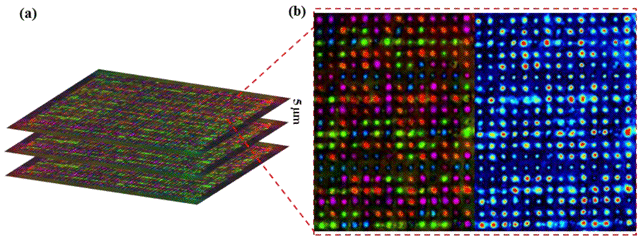Quartz disk can store information for a million years

(a) An information recording facility consists of a femtosecond laser, spatial light modulator (SLM), Fourier lenses (FL), half-wave phase plate (λ / 2 M), a dichromatic mirror, an immersion lens 1.2 NA, a quartz glass sample and a platform . (b) Color codes of a matrix with a half-wave phase plate imprinted in silica glass to control polarization.
For the first time in the world, scientists from the University of Southampton were able to successfully record and read information from a five-dimensional medium (5D) in quartz glass.
Due to its strength and chemical inertness, quartz glass is a unique information carrier. A quartz glass disk can potentially hold up to 360 terabytes of information, while withstanding temperatures up to 1000 ° C and has an almost unlimited shelf life.
In the “memory crystals” of fused quartz, information is recorded in five dimensions: coordinates in 3D space, orientation and size. The last two parameters are controlled by the polarization and intensity of the laser beam.
During the experiment, a 300-kilobyte text file was successfully written to the crystal. The file was recorded using a femtosecond laser with a wavelength of 1030 nm, pulses of 8 microjoules with a duration of 280 femtoseconds with a frequency of 200 kHz, by burning points in the crystal, layers at a distance of 5 μm from each other (1 micrometer - one millionth meter) at a depth of 140 microns from the surface of quartz glass.

Recorded data in three layers, approximation 60x.
To demonstrate the technology, recording was carried out in two different ways: 1 bit at a point, in the illustration - (b) to the right, and 4 bits at a point, in illustration (b) to the left.
The use of a spatial light modulator and a half-wave phase plate allows one to get rid of moving components in a recording setup.
Scorched points change the optical characteristics of the crystal and the polarization of the light passing through it, which can be detected using an optical microscope and a polarizer. It is this combination of devices that is used to read information. During the experiment, an Olympus BX51 optical microscope was used with a birefringence measurement system.

Quartz disk with recorded information A
slow but durable new type of memory can be used for backing up information. Especially in companies that are able to buy a femtosecond laser for $ 100 thousand. The
scientific work “5D Data Storage by Ultrafast Laser Nanostructuring in Glass” (pdf) was presented at the conference on lasers and optoelectronics (CLEO'13) in San Jose.
